Hey all,
I recently resurrected my cornus and checked the in-room frequency response using fuzzmeasure. Overall they measure quite well, and are reasonably flat through their range, however they do suffer from a tremendous suckout between 100 and 200hz. Mounting the speakers closer to the floor aggravated the dip but the location remained the same, so I don't think it's floor bounce; there seems to be cancellation occurring between the various horns. My question is whether or not others have measured this, and if so, if anyone has come up with a solution.
Chaz,
I thought you gave up on the Cornu's in favor of you TL's...
The Cornu's sound amazingly nice for what they are especially considering how easy they are to make, and how we took the liberty to scale them at will from original design.
I am now starting from scratch using the concept of designing a double horn that doesn't cancel. Simulate it and maybe build box variant. If it works make it into spiral by rolling it up. The design really matters because I was able to make the double remove a major dip at 200 Hz. See the post in the foam core thread and also in the Akabak http://www.diyaudio.com/forums/full-range/235846-running-akabak-2.html#post3496353 thread. It might be worth starting its own thread soon to keep it from getting lost inside the huge FC thread.
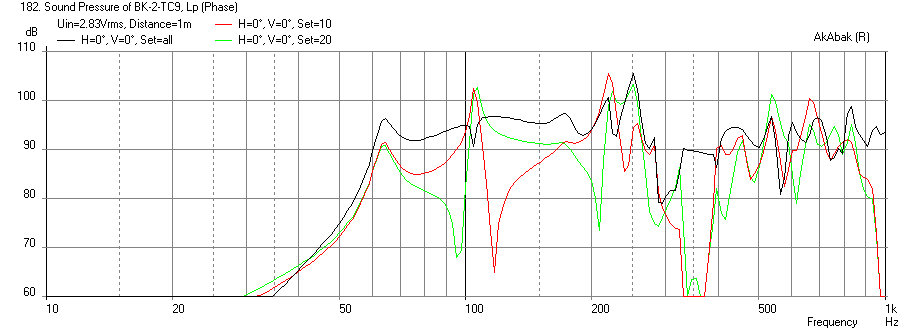
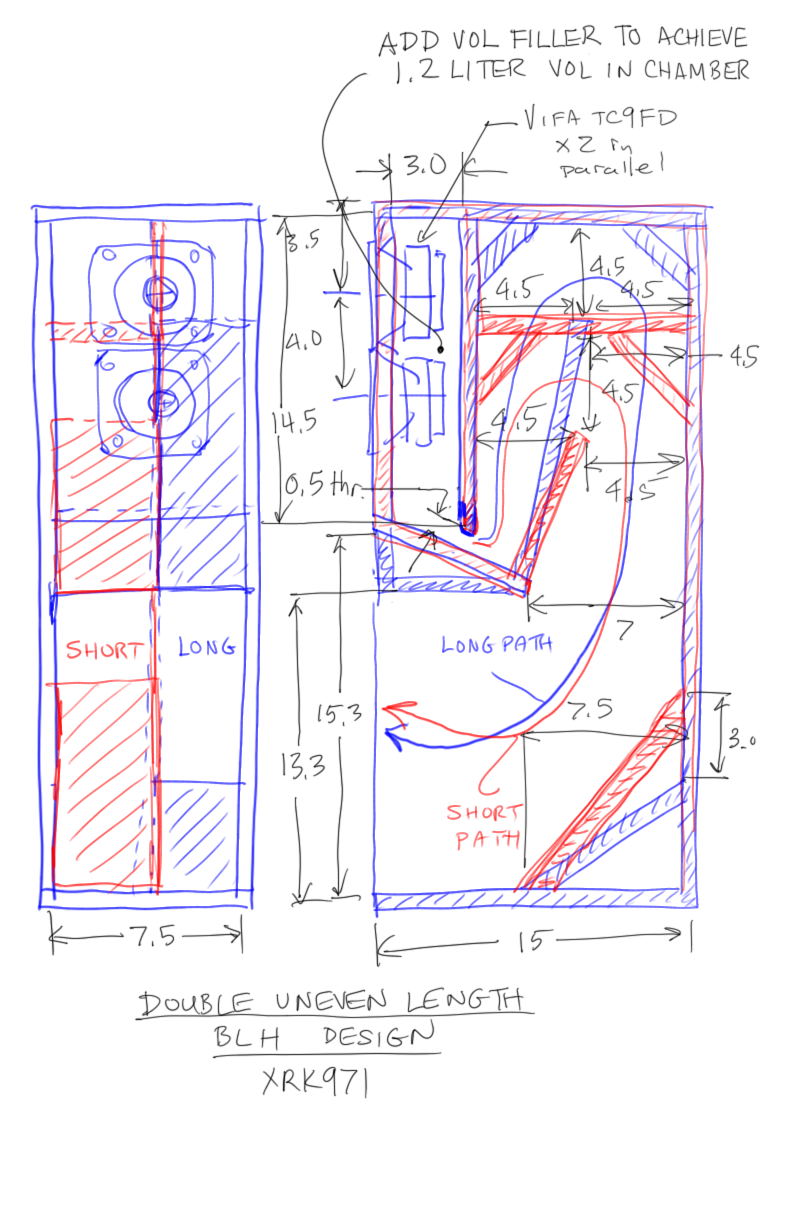
For measurements of Cornu, see Pano's posted either here or in FC tread.
Last edited:
FWIW, here are the frequency response graphs. I'm using this driver: Tang Band W3-926SDF 3" Full Range Speaker 264-912 . These are in-room plots from my listening position, so it gives you some idea of what I'm hearing. One nice thing is that there's definitely usable bass to 60hz.
Attachments
FWIW, here are the frequency response graphs. I'm using this driver: Tang Band W3-926SDF 3" Full Range Speaker 264-912 . These are in-room plots from my listening position, so it gives you some idea of what I'm hearing. One nice thing is that there's definitely usable bass to 60hz.
Pano's meas with Vifa and 20 in Cornu.
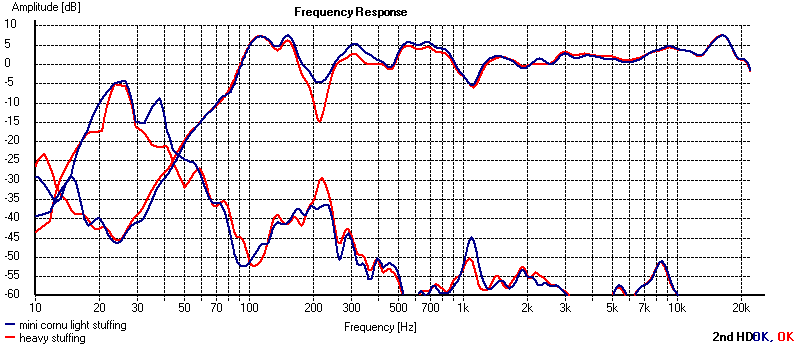
Gluing up covers
One way to even up the foam core strips is to glue some sandpaper to a flat surface (such as plywood). Then turn the built up channels upside down and gently sand all the strips level. The glued up channels are surprisingly rigid, so if you're careful you should be able to get everything of equal height to make the final gluing more likely to seal all the channels.
Reading this Thread and thanks to all the contributors, I decided to build a new 70 cornu speaker with the Vifa TC9FD. The channel depth is 9.5 cm
A little bit concerned on closing the speaker with the top ply plate: the internal foamcore strips are not so accurate in width and I cannot grant perfect matching. Any suggestion?
One way to even up the foam core strips is to glue some sandpaper to a flat surface (such as plywood). Then turn the built up channels upside down and gently sand all the strips level. The glued up channels are surprisingly rigid, so if you're careful you should be able to get everything of equal height to make the final gluing more likely to seal all the channels.
Yes, it's been a long time.Chaz,
I thought you gave up on the Cornu's in favor of you TL's...
So this morning I did more experiments with asymmetrical stuffing and I think I'm getting somewhere. The problem, of course, is that I can't get inside to change the stuffing early on in the line, but I am able to adjust at the end. I have a feeling that if I could get inside again, I could make a bigger difference. Anyway, below are some charts to show the progress I've made.
If you look at the 1/48 octave smoothing, it's apparent that the cancellation is still deep but much narrower in band than before. At 1/12 octave smoothing, the frequency response stays within +/- 3db throughout its range (excluding the suckout) in-room! Not bad. If I really want to stroke my ego I can switch to 1/6 octave and I get +/- 2db like in the second chart. Overall I'm impressed with how linear this tangband driver is. Another thing that surprises me is that I don't see any cancellation around 1-2k from the rear wave bouncing off the wall and back through the driver.
Attachments
Simulations of Cornu with 4 horns and wall/floor BC's
I had a request to simulate the Cornu for a W5-1611 driver. This will require a 90 x 90 cm (35.4 in baffle) x 9 cm deep. I used Don Hills's original 2-horn sim and augmented it for 4 horns radiating out at proper orientation and positions. These are for the speaker mounted 2 m from floor at driver centerline, 1 m and 3 m away at 1 watt with a driver chamber volume fraction of 70%. As we all know the Cornu had tremendous bass gain and use of stuffing will be needed to attenuate the bass gain. What may be problematic is the upper bass gain is huge - and may be difficult to attenuate. I tried two different orientations with long paths up down or right left and it did not change things too much.
Plots are left to right: freq response at 1 m (red is short horn, green is long horn, black is combined with driver direct radiation), freq response at 3m, impedance, driver displacement, polar dispersion for 100hz, 1khz, 2khz, and freq response reference design with 75cm x 10cm Cornu for FE108Sigma at 3m.
I had a request to simulate the Cornu for a W5-1611 driver. This will require a 90 x 90 cm (35.4 in baffle) x 9 cm deep. I used Don Hills's original 2-horn sim and augmented it for 4 horns radiating out at proper orientation and positions. These are for the speaker mounted 2 m from floor at driver centerline, 1 m and 3 m away at 1 watt with a driver chamber volume fraction of 70%. As we all know the Cornu had tremendous bass gain and use of stuffing will be needed to attenuate the bass gain. What may be problematic is the upper bass gain is huge - and may be difficult to attenuate. I tried two different orientations with long paths up down or right left and it did not change things too much.
Plots are left to right: freq response at 1 m (red is short horn, green is long horn, black is combined with driver direct radiation), freq response at 3m, impedance, driver displacement, polar dispersion for 100hz, 1khz, 2khz, and freq response reference design with 75cm x 10cm Cornu for FE108Sigma at 3m.
Attachments
-
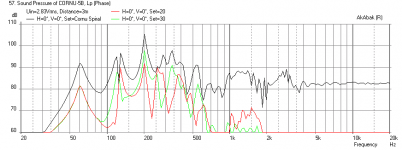 Cornu-75x10cm-FE108Sigma-Freq-3m.png27.3 KB · Views: 92
Cornu-75x10cm-FE108Sigma-Freq-3m.png27.3 KB · Views: 92 -
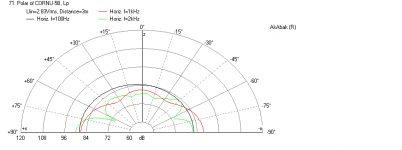 Cornu-90x9cm-W5-1611-Polar-3m.png16.7 KB · Views: 482
Cornu-90x9cm-W5-1611-Polar-3m.png16.7 KB · Views: 482 -
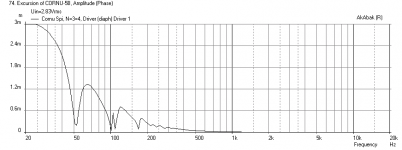 Cornu-90x9cm-W5-1611-Displ.png20.8 KB · Views: 489
Cornu-90x9cm-W5-1611-Displ.png20.8 KB · Views: 489 -
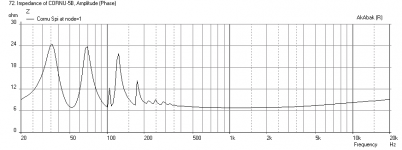 Cornu-90x9cm-W5-1611-Impedance.png21.9 KB · Views: 492
Cornu-90x9cm-W5-1611-Impedance.png21.9 KB · Views: 492 -
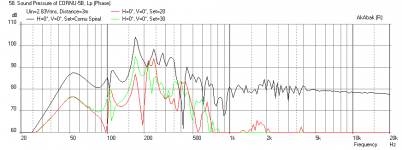 Cornu-90x9cm-W5-1611-Freq-3m.png27.1 KB · Views: 514
Cornu-90x9cm-W5-1611-Freq-3m.png27.1 KB · Views: 514 -
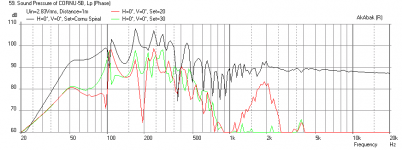 Cornu-90x9cm-W5-1611-Freq-1m.png27.8 KB · Views: 507
Cornu-90x9cm-W5-1611-Freq-1m.png27.8 KB · Views: 507
I'll volunteer to give this a try. Those massive midrange peaks looks nasty at first, but if eq'd back to flat it could dramatically reduce midrange distortion since the horns are doing so much of the work for the driver. At least I hope so!
Thanks xrk for running the simulations.
Thanks xrk for running the simulations.
Chaz,
Here is a simulation of a 90 cm x 90 cm x 10.14 cm deep Cornu for the TB W5-1611 driver at various driver heights above the floor. All at 3 m listening position. First is 0.8m, 1.0m, 1.2m, 1.5m, 1.8m, 2.0m.
Good luck on your build!
X
Here is a simulation of a 90 cm x 90 cm x 10.14 cm deep Cornu for the TB W5-1611 driver at various driver heights above the floor. All at 3 m listening position. First is 0.8m, 1.0m, 1.2m, 1.5m, 1.8m, 2.0m.
Good luck on your build!
X
Attachments
-
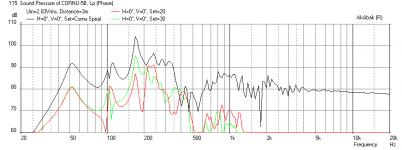 Cornu-90x10.14cm-W5-1611-Freq-2.0m-height.png27.3 KB · Views: 75
Cornu-90x10.14cm-W5-1611-Freq-2.0m-height.png27.3 KB · Views: 75 -
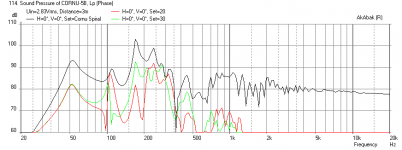 Cornu-90x10.14cm-W5-1611-Freq-1.8m-height.png27.5 KB · Views: 79
Cornu-90x10.14cm-W5-1611-Freq-1.8m-height.png27.5 KB · Views: 79 -
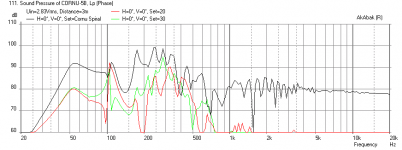 Cornu-90x10.14cm-W5-1611-Freq-1.5m-height.png27 KB · Views: 74
Cornu-90x10.14cm-W5-1611-Freq-1.5m-height.png27 KB · Views: 74 -
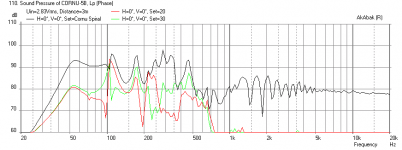 Cornu-90x10.14cm-W5-1611-Freq-1.2m-height.png26.6 KB · Views: 83
Cornu-90x10.14cm-W5-1611-Freq-1.2m-height.png26.6 KB · Views: 83 -
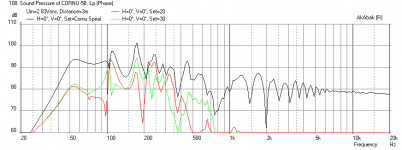 Cornu-90x10.14cm-W5-1611-Freq-1m-height.png26.6 KB · Views: 108
Cornu-90x10.14cm-W5-1611-Freq-1m-height.png26.6 KB · Views: 108 -
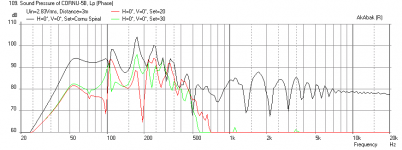 Cornu-90x10.14cm-W5-1611-Freq-0.8m-height.png26.9 KB · Views: 111
Cornu-90x10.14cm-W5-1611-Freq-0.8m-height.png26.9 KB · Views: 111
Last edited:
Have these sims all been run on the assumption that the W5-1611 has a Qts of ~.4?
looking at these graphs, what do you suppose if I just block the two short horns at .8m height, or perhaps block one of each? The output might be more balanced that way.
looking at these graphs, what do you suppose if I just block the two short horns at .8m height, or perhaps block one of each? The output might be more balanced that way.
Last edited by a moderator:
I used Qms=1.67 Qes=0.60 for Qts=0.44. This is the discontinued Nd driver model. The ferrite has same Qts but different Qes and Qms. Which version do you have? I can try blocking channels to see if it helps. Seems to defeat point of quad horn though. This is why stuffing is important to attenuate bass to match HF.
The W5 often seems to have a Qts closer to .5 or .6 (See: Tang Band W5-1611, what is it?), which will throw things off a bit, and in the direction of more bass, no less...Just what we need! Obviously a low Qts woofer would be a better fit.
And I agree, cutting off two horns defeats the purpose of the design, but it might also make the speakers more useful until I can construct an appropriate filter...
And I agree, cutting off two horns defeats the purpose of the design, but it might also make the speakers more useful until I can construct an appropriate filter...
Sim of Effect of Blocking Horns & Measured T/S Params
Chaz,
I ran some cases with the measured T/S parameters from the PE discussion thread that you pointed to above. Plot 1 is for speaker mounted at 1.2 m height centerline and listening position is 3 m away: a mildly different driver - actually better for flat bass performance with deeper extension as you guessed.
Plot 2 shows the effect of blocking both the short horns. Plot 3 shows effect of blocking both of the long horns. Plot 4 shows effect of blocking one long and one short (or half of the horns evenly). I don't think any of the alternatives produce a better response. I wish I can model damping but I bet it will reduce overall bass amplitude and tame those high peaks in the 150 to 300 Hz range.
Now I know why the Cornu company offered the front horn: it's the only way to boost the gain of the mids and high frequencies to match the massive output of the bass. I think this exercise really is showing theoretically why that may be the only viable solution apart from EQ the input. If you can boost the efficiency of the output (in effect a reverse BSC) the output at 3 m and beyond will be much more balanced. I will take shot at adding a short front conical or exponential horn or wave guide to the driver direct radiation and see if it doesn't balance things out. I think I am looking for a horn that gives 10 dB gain from 500 Hz up.
Using exponential horn theory, the flare constant m=(4 pi fc) / c, mouth area Sl = (c / 2fc)^2 / pi, where c is speed of sound, fc is the lower cutoff freq (500 Hz), I calculate a flare rate of 18.4 m^-1. Mouth area is thus calculated to be 370 cm^2 (or for a square horn about 8 in x 8 in). Using equation m= ln(Sl/So)/L to relate flare rate to mouth size knowing So equals driver Sd (94 cm^2), we get L=19.5 cm or about 8 in. So a square cross section exponential horn that fits over the driver aperture and expands to 8 in x 8 in over a distance of 8 in is what I need to build into the model. Done. That wasn't too hard and pictorially, matches the shape that Cornu offers on their website.
Chaz,
I ran some cases with the measured T/S parameters from the PE discussion thread that you pointed to above. Plot 1 is for speaker mounted at 1.2 m height centerline and listening position is 3 m away: a mildly different driver - actually better for flat bass performance with deeper extension as you guessed.
Plot 2 shows the effect of blocking both the short horns. Plot 3 shows effect of blocking both of the long horns. Plot 4 shows effect of blocking one long and one short (or half of the horns evenly). I don't think any of the alternatives produce a better response. I wish I can model damping but I bet it will reduce overall bass amplitude and tame those high peaks in the 150 to 300 Hz range.
Now I know why the Cornu company offered the front horn: it's the only way to boost the gain of the mids and high frequencies to match the massive output of the bass. I think this exercise really is showing theoretically why that may be the only viable solution apart from EQ the input. If you can boost the efficiency of the output (in effect a reverse BSC) the output at 3 m and beyond will be much more balanced. I will take shot at adding a short front conical or exponential horn or wave guide to the driver direct radiation and see if it doesn't balance things out. I think I am looking for a horn that gives 10 dB gain from 500 Hz up.
Using exponential horn theory, the flare constant m=(4 pi fc) / c, mouth area Sl = (c / 2fc)^2 / pi, where c is speed of sound, fc is the lower cutoff freq (500 Hz), I calculate a flare rate of 18.4 m^-1. Mouth area is thus calculated to be 370 cm^2 (or for a square horn about 8 in x 8 in). Using equation m= ln(Sl/So)/L to relate flare rate to mouth size knowing So equals driver Sd (94 cm^2), we get L=19.5 cm or about 8 in. So a square cross section exponential horn that fits over the driver aperture and expands to 8 in x 8 in over a distance of 8 in is what I need to build into the model. Done. That wasn't too hard and pictorially, matches the shape that Cornu offers on their website.
Attachments
-
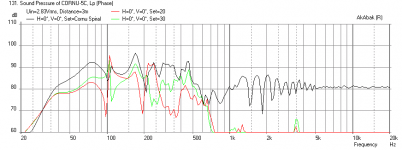 Cornu-90x10.14cm-W5-1611-Freq-1.2m-height-TS-meas-3-meters-Disconnect-Half-Horn.png26.7 KB · Views: 68
Cornu-90x10.14cm-W5-1611-Freq-1.2m-height-TS-meas-3-meters-Disconnect-Half-Horn.png26.7 KB · Views: 68 -
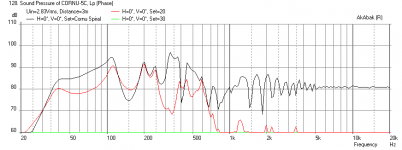 Cornu-90x10.14cm-W5-1611-Freq-1.2m-height-TS-meas-3-meters-Disconnect-Long-Horn.png25.5 KB · Views: 73
Cornu-90x10.14cm-W5-1611-Freq-1.2m-height-TS-meas-3-meters-Disconnect-Long-Horn.png25.5 KB · Views: 73 -
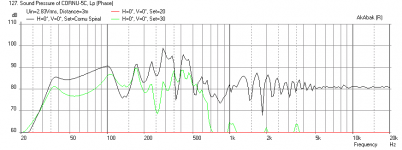 Cornu-90x10.14cm-W5-1611-Freq-1.2m-height-TS-meas-3-meters-Disconnect-Short-Horn.png25.3 KB · Views: 702
Cornu-90x10.14cm-W5-1611-Freq-1.2m-height-TS-meas-3-meters-Disconnect-Short-Horn.png25.3 KB · Views: 702 -
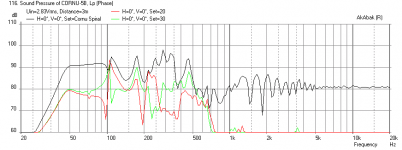 Cornu-90x10.14cm-W5-1611-Freq-1.2m-height-TS-meas-3-meters.png26.6 KB · Views: 104
Cornu-90x10.14cm-W5-1611-Freq-1.2m-height-TS-meas-3-meters.png26.6 KB · Views: 104
Last edited:
90 cm x 10 cm Cornu with Front Horn
Based on my previous post trying to figure out ways to balance the frequency response, I saw that a front mounted horn to boost the mids and highs would probably be the only way to fix this.
I started with an 8 in x 8 in x 8 in deep conical horn but that turned out to be too much gain at 500 Hz and produced a peak near 500 Hz. I reduced the length to 4 in 910 cm) and boosted the horn mouth to 9 in (23 cm) with a throat of 11 cm x 11 cm to match the driver's aperture.
With this front horn addition (which required only about 8 lines of code in the script), the freq performance balances much more nicely at a listening position of 3 meters. Note the efficiency of the system is now about 90 dB from 47 Hz up to 2 kHz at 3 meters away with 1 watt!
First plot it impedance, second is cone displacement, third is polar, fourth is impulse, fifth is freq (front horn in red, long back horn in green and black is overall).
The front horn is very simple: 11 cm x 11 cm throat to 23 cm x 23 cm mouth, 10 cm deep (perpendicular direction), straight conical section.
Based on my previous post trying to figure out ways to balance the frequency response, I saw that a front mounted horn to boost the mids and highs would probably be the only way to fix this.
I started with an 8 in x 8 in x 8 in deep conical horn but that turned out to be too much gain at 500 Hz and produced a peak near 500 Hz. I reduced the length to 4 in 910 cm) and boosted the horn mouth to 9 in (23 cm) with a throat of 11 cm x 11 cm to match the driver's aperture.
With this front horn addition (which required only about 8 lines of code in the script), the freq performance balances much more nicely at a listening position of 3 meters. Note the efficiency of the system is now about 90 dB from 47 Hz up to 2 kHz at 3 meters away with 1 watt!
First plot it impedance, second is cone displacement, third is polar, fourth is impulse, fifth is freq (front horn in red, long back horn in green and black is overall).
The front horn is very simple: 11 cm x 11 cm throat to 23 cm x 23 cm mouth, 10 cm deep (perpendicular direction), straight conical section.
Attachments
-
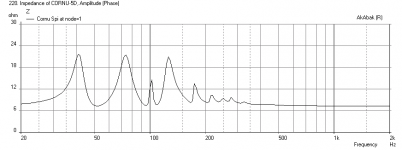 Cornu-90x10.14cm-W5-1611-Freq-1.2m-height-TS-meas-3-meters-FrontHorn-Impedance.png19.5 KB · Views: 88
Cornu-90x10.14cm-W5-1611-Freq-1.2m-height-TS-meas-3-meters-FrontHorn-Impedance.png19.5 KB · Views: 88 -
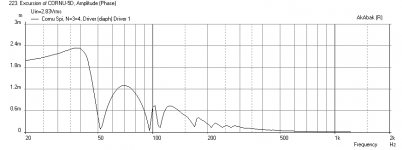 Cornu-90x10.14cm-W5-1611-Freq-1.2m-height-TS-meas-3-meters-FrontHorn-Displ.png19 KB · Views: 75
Cornu-90x10.14cm-W5-1611-Freq-1.2m-height-TS-meas-3-meters-FrontHorn-Displ.png19 KB · Views: 75 -
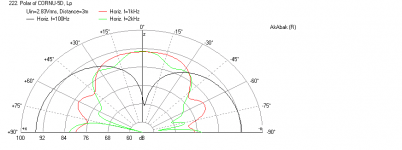 Cornu-90x10.14cm-W5-1611-Freq-1.2m-height-TS-meas-3-meters-FrontHorn-Polar.png18 KB · Views: 69
Cornu-90x10.14cm-W5-1611-Freq-1.2m-height-TS-meas-3-meters-FrontHorn-Polar.png18 KB · Views: 69 -
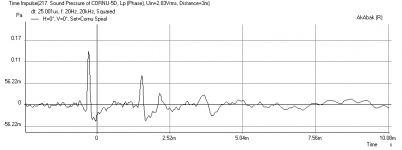 Cornu-90x10.14cm-W5-1611-Freq-1.2m-height-TS-meas-3-meters-FrontHorn-Impulse.png14.3 KB · Views: 63
Cornu-90x10.14cm-W5-1611-Freq-1.2m-height-TS-meas-3-meters-FrontHorn-Impulse.png14.3 KB · Views: 63 -
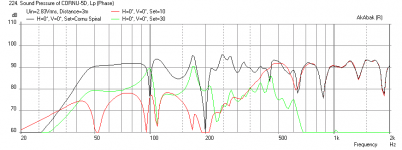 Cornu-90x10.14cm-W5-1611-Freq-1.2m-height-TS-meas-3-meters-FrontHorn-Freq.png24.7 KB · Views: 907
Cornu-90x10.14cm-W5-1611-Freq-1.2m-height-TS-meas-3-meters-FrontHorn-Freq.png24.7 KB · Views: 907
Last edited:
Wow, that sensitivity is quite impressive.
Okay, so I'll go ahead and built a test speaker and try out all three options: short bass horns blocked, long bass horns blocked, and then all bass horns opened up with a midrange horn on the front. Not sure when I'll have it done, but I hope it's soon.
Okay, so I'll go ahead and built a test speaker and try out all three options: short bass horns blocked, long bass horns blocked, and then all bass horns opened up with a midrange horn on the front. Not sure when I'll have it done, but I hope it's soon.
- Home
- Loudspeakers
- Full Range
- Ever think of building a Cornu Spiral horn? Now you can!